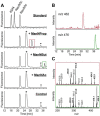Artificial and natural sialic acid precursors influence the angiogenic capacity of human umbilical vein endothelial cells
- PMID: 23442933
- PMCID: PMC6269824
- DOI: 10.3390/molecules18032571
Artificial and natural sialic acid precursors influence the angiogenic capacity of human umbilical vein endothelial cells
Abstract
N-acetylneuraminic acid (Neu5Ac) represents the most common terminal carbohydrate residue in many mammalian glycoconjugates and is directly involved in a number of different physiological as well as pathological cellular processes. Endogenous sialic acids derive from the biosynthetic precursor molecule N-acetyl-D-mannosamine (ManNAc). Interestingly, N-acyl-analogues of D-mannosamine (ManN) can also be incorporated and converted into corresponding artificial sialic acids by eukaryotic cells. Within this study, we optimized a protocol for the chemical synthesis of various peracetylated ManN derivatives resulting in yields of approximately 100%. Correct molecular structures of the obtained products ManNAc, N-propanoyl-ManN (ManNProp) and N-butyl-ManN (ManNBut) were verified by GC-, ESI-MS- and NMR-analyses. By applying these substances to human umbilical vein endothelial cells (HUVECs), we could show that each derivative was metabolized to the corresponding N-acylneuraminic acid variant and subsequently incorporated into nascent glycoproteins. To investigate whether natural and/or artificial sialic acid precursors are able to modulate the angiogenic capacity of HUVECs, a spheroid assay was performed. By this means, an increase in total capillary length has been observed when cells incorporated N-butylneuraminic acid (Neu5But) into their glycoconjugates. In contrast, the natural precursor ManNAc inhibited the growth of capillaries. Thus, sialic acid precursors may represent useful agents to modulate blood vessel formation.
Figures






Similar articles
-
Biochemical engineering of the N-acyl side chain of sialic acid: biological implications.Glycobiology. 2001 Feb;11(2):11R-18R. doi: 10.1093/glycob/11.2.11r. Glycobiology. 2001. PMID: 11287396 Review.
-
Metabolic Glycoengineering of Sialic Acid Using N-acyl-modified Mannosamines.J Vis Exp. 2017 Nov 25;(129):55746. doi: 10.3791/55746. J Vis Exp. 2017. PMID: 29286437 Free PMC article.
-
Biochemical engineering of the acyl side chain of sialic acids stimulates integrin-dependent adhesion of HL60 cells to fibronectin.J Mol Med (Berl). 2002 Oct;80(10):671-7. doi: 10.1007/s00109-002-0382-y. Epub 2002 Sep 19. J Mol Med (Berl). 2002. PMID: 12395152
-
Pro-angiogenic activity of notoginsenoside R1 in human umbilical vein endothelial cells in vitro and in a chemical-induced blood vessel loss model of zebrafish in vivo.Chin J Integr Med. 2016 Jun;22(6):420-9. doi: 10.1007/s11655-014-1954-8. Epub 2014 Dec 22. Chin J Integr Med. 2016. PMID: 25533511
-
Beyond glycosylation: sialic acid precursors act as signaling molecules and are involved in cellular control of differentiation of PC12 cells.Biol Chem. 2009 Jul;390(7):575-9. doi: 10.1515/BC.2009.058. Biol Chem. 2009. PMID: 19361277 Review.
Cited by
-
Artificial Polysialic Acid Chains as Sialidase-Resistant Molecular-Anchors to Accumulate Particles on Neutrophil Extracellular Traps.Front Immunol. 2017 Sep 29;8:1229. doi: 10.3389/fimmu.2017.01229. eCollection 2017. Front Immunol. 2017. PMID: 29033944 Free PMC article.
-
Sialylated Cervical Mucins Inhibit the Activation of Neutrophils to Form Neutrophil Extracellular Traps in Bovine in vitro Model.Front Immunol. 2019 Nov 6;10:2478. doi: 10.3389/fimmu.2019.02478. eCollection 2019. Front Immunol. 2019. PMID: 31781090 Free PMC article.
-
Sialic Acid Metabolic Engineering of Breast Cancer Cells Interferes with Adhesion and Migration.Molecules. 2020 Jun 5;25(11):2632. doi: 10.3390/molecules25112632. Molecules. 2020. PMID: 32517035 Free PMC article.
-
Protective effect of troxerutin and cerebroprotein hydrolysate injection on cerebral ischemia through inhibition of oxidative stress and promotion of angiogenesis in rats.Mol Med Rep. 2019 Apr;19(4):3148-3158. doi: 10.3892/mmr.2019.9960. Epub 2019 Feb 15. Mol Med Rep. 2019. PMID: 30816516 Free PMC article.
-
Inhibition of protein glycosylation is a novel pro-angiogenic strategy that acts via activation of stress pathways.Nat Commun. 2020 Dec 10;11(1):6330. doi: 10.1038/s41467-020-20108-0. Nat Commun. 2020. PMID: 33303737 Free PMC article.
References
Publication types
MeSH terms
Substances
LinkOut - more resources
Full Text Sources
Other Literature Sources
Miscellaneous

